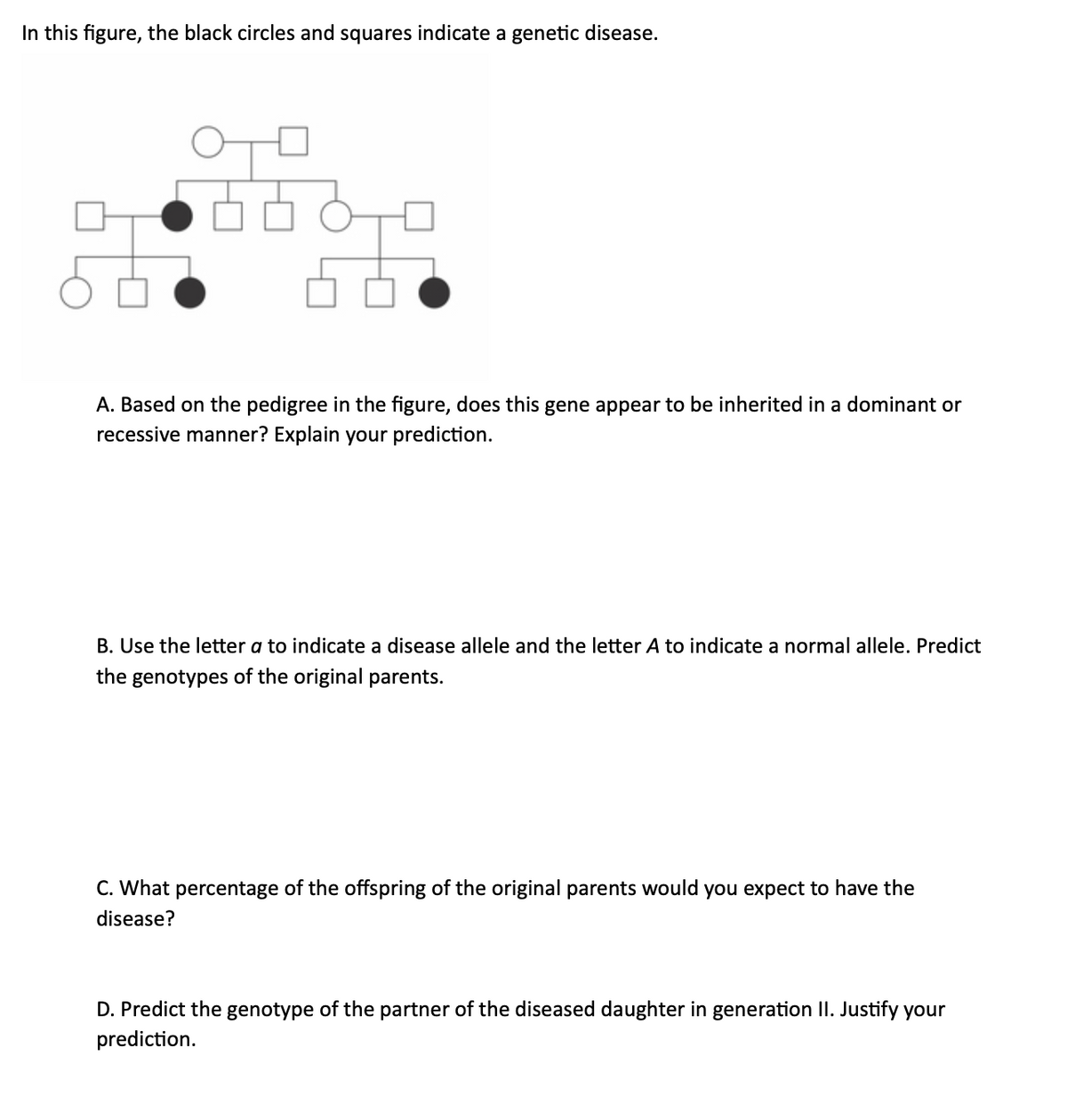In this figure, the black circles and squares indicate a genetic disease. A. Based on the pedigree in the figure, does this gene appear to be inherited in a dominant or recessive manner? Explain your prediction. B. Use the letter a to indicate a disease allele and the letter A to indicate a normal allele. Predict the genotypes of the original parents. C. What percentage of the offspring of the original parents would you expect to have the disease? D. Predict the genotype of the partner of the diseased daughter in generation II. Justify your prediction.
In this figure, the black circles and squares indicate a genetic disease. A. Based on the pedigree in the figure, does this gene appear to be inherited in a dominant or recessive manner? Explain your prediction. B. Use the letter a to indicate a disease allele and the letter A to indicate a normal allele. Predict the genotypes of the original parents. C. What percentage of the offspring of the original parents would you expect to have the disease? D. Predict the genotype of the partner of the diseased daughter in generation II. Justify your prediction.
Human Anatomy & Physiology (11th Edition)
11th Edition
ISBN:9780134580999
Author:Elaine N. Marieb, Katja N. Hoehn
Publisher:Elaine N. Marieb, Katja N. Hoehn
Chapter1: The Human Body: An Orientation
Section: Chapter Questions
Problem 1RQ: The correct sequence of levels forming the structural hierarchy is A. (a) organ, organ system,...
Related questions
Topic Video
Question

Transcribed Image Text:In this figure, the black circles and squares indicate a genetic disease.
A. Based on the pedigree in the figure, does this gene appear to be inherited in a dominant or
recessive manner? Explain your prediction.
B. Use the letter a to indicate a disease allele and the letter A to indicate a normal allele. Predict
the genotypes of the original parents.
C. What percentage of the offspring of the original parents would you expect to have the
disease?
D. Predict the genotype of the partner of the diseased daughter in generation II. Justify your
prediction.
Expert Solution
Step 1
When even one member of the family has a genetic condition, analyzing the pedigree can provide information about the pattern of inheritance of the ailment and the significant threat to other family members. Gene penetrance and gene expressivity can also be estimated via pedigree analysis.
Trending now
This is a popular solution!
Step by step
Solved in 3 steps

Follow-up Questions
Read through expert solutions to related follow-up questions below.
Follow-up Question
What percent of the offspring of these parents would you expect to have the disease?
Solution
Knowledge Booster
Learn more about
Need a deep-dive on the concept behind this application? Look no further. Learn more about this topic, biology and related others by exploring similar questions and additional content below.Recommended textbooks for you

Human Anatomy & Physiology (11th Edition)
Biology
ISBN:
9780134580999
Author:
Elaine N. Marieb, Katja N. Hoehn
Publisher:
PEARSON

Biology 2e
Biology
ISBN:
9781947172517
Author:
Matthew Douglas, Jung Choi, Mary Ann Clark
Publisher:
OpenStax

Anatomy & Physiology
Biology
ISBN:
9781259398629
Author:
McKinley, Michael P., O'loughlin, Valerie Dean, Bidle, Theresa Stouter
Publisher:
Mcgraw Hill Education,

Human Anatomy & Physiology (11th Edition)
Biology
ISBN:
9780134580999
Author:
Elaine N. Marieb, Katja N. Hoehn
Publisher:
PEARSON

Biology 2e
Biology
ISBN:
9781947172517
Author:
Matthew Douglas, Jung Choi, Mary Ann Clark
Publisher:
OpenStax

Anatomy & Physiology
Biology
ISBN:
9781259398629
Author:
McKinley, Michael P., O'loughlin, Valerie Dean, Bidle, Theresa Stouter
Publisher:
Mcgraw Hill Education,

Molecular Biology of the Cell (Sixth Edition)
Biology
ISBN:
9780815344322
Author:
Bruce Alberts, Alexander D. Johnson, Julian Lewis, David Morgan, Martin Raff, Keith Roberts, Peter Walter
Publisher:
W. W. Norton & Company

Laboratory Manual For Human Anatomy & Physiology
Biology
ISBN:
9781260159363
Author:
Martin, Terry R., Prentice-craver, Cynthia
Publisher:
McGraw-Hill Publishing Co.

Inquiry Into Life (16th Edition)
Biology
ISBN:
9781260231700
Author:
Sylvia S. Mader, Michael Windelspecht
Publisher:
McGraw Hill Education